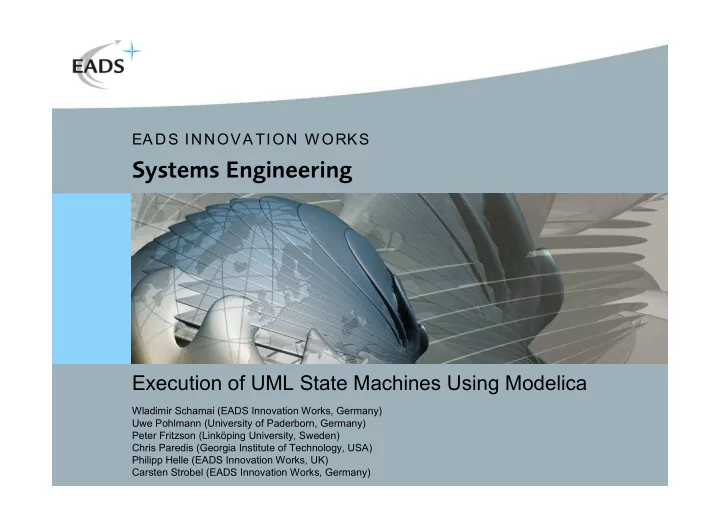

EA DS INNOVA TION W ORKS Systems Engineering Execution of UML State Machines Using Modelica Wladimir Schamai (EADS Innovation Works, Germany) Uwe Pohlmann (University of Paderborn, Germany) Peter Fritzson (Linköping University, Sweden) Chris Paredis (Georgia Institute of Technology, USA) Philipp Helle (EADS Innovation Works, UK) Carsten Strobel (EADS Innovation Works, Germany)
Table of Contents Introduction and Motivation UML state machines to Modelica - translation approach UML state machine concepts supported in ModelicaML UML state machines execution semantics issues Conclusion
Introduction: ModelicaML Concept
Introduction: ModelicaML Graphical Notation Structure Requirements Behavior
Introduction: Motivation UML state machines is a powerful formalism for describing system or components states and modes To which extent can UML state machines concepts be supported in ModelicaML? How to implement it? – Create a Modelica library or implement a code generator? – Use algorithmic code or equations? This presentation focuses on the resolution of issues identified when translating UML state machines into executable Modelica code
Translation Approach Code generator approach was chosen instead library – States specification (i.e. in/outgoing transitions, entry, do, exit actions) cannot be predefined as a library component. ModelicaML code generator generates algorithmic Modelica code from ModelicaML state machines because: – The behavior of a state machine is always causal – For inter-level transitions, i.e. transitions which cross states hierarchy borders, the deactivation and activation of states and the execution sequence of associated actions (exit/entry action of states or state transitions effects) has to be performed in an explicitly defined order.
Simple Example (1/2)
Simple Example (2/2)
UML State Machine Concepts Supported in ModelicaML Hierarchical states modeling – Composite states – Sub-state machines (reusable for multiple states) Regions (orthogonal states) Pseudo states – initial , shallowHistory, join, fork, junction, choice, entryPoint, exitPoint, terminate Transition – Compound transitions (a transitions set from state to state through pseudo states) – Inter-level transition (transitions that cross hierarchy levels) Events – Change Events, Time Events, Signal Events State Actions – onEntry, Do, onExit
Issues with Conflicting Transitions What happens when x and y are greater than 2 at the same time? In ModelicaML: Transition which the higher execution priority is taken (i.e. to state OK)
Priority Schema for Conflicting Transitions at Different State Hierarchy Levels What happens when x and y are greater that 2 at the same time? In ModelicaML: Transition to state “OK” is taken because it is at higher hierarchy level
Issue with Concurrent Execution in Regions What is openValve set to? In ModelicaML: To “false” because Region_0 was executed first and then Region_1 is execute.
Issues With Concurrency When Using Event Queues (1/4) -State machine enters the state_0 in both regions -On entry ev1 and ev2 are generated in state_0 in both regions -Transitions to state_1 is performed in both regions -… What are the resulting active states configuration?
Issues With Concurrency When Using Event Queues (2/4) Simulation result in IBM Rhapsody Active (resulting) states
Issues With Concurrency When Using Event Queues (3/4) Simulation result in IBM Rhapsody Active (resulting) states
Issues With Concurrency When Using Event Queues (4/4) What are the resulting states? In ModelicaML: Independent of whether ev1 is generated in Region_0 or in Region_1 the state machine ends up in state_1 in both regions because both events are generated when the state machines is in state_0 in both regions and are both consumed after the transition to state_1 is performed.
Issues with Inter-Level Transitions In which order are the states activated when cond1 becomes true? b, c, d, e2, i, h, g, f b, c, d, e2, i, g, h, f b, c, d, e2, f, g, h, i b, c, d, e2, f, h, g, i In ModelicaML: b, c, d, e2, f, g, h, i
Issues with Fork and Join In which sequence are states b, c, d, e, and f activated when the transitions (fork construct) from state a is executed? In ModelicaML: b, d and e (based on the fork-outgoing transitions priority) , c and f (based on their region priority)
Issues with Instantaneous States: Deadlocks (Infinite Looping) Time-delayed transitions for breaking infinite looping at the same time instant.
Conclusion Using Modelica as execution language it is possible to support a comprehensive set of UML state machines specification Suggested improvement of the UML state machines specification – Priority for conflicting state-outgoing transitions – Priority for regions This enhancement of specification will clarify semantic and ensure • That state machine behavior is deterministic • That state machine behaves as intended by the modeler
Thank you for your attention! EADS Innovation Works Systems Engineering Team Wladimir Schamai Wladimir.Schamai@eads.net
Recommend
More recommend